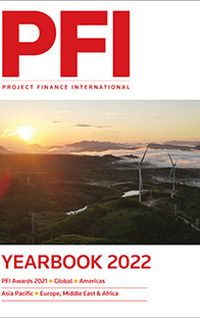Bank of the Year – MUFG
MUFG was the top Americas project finance bank for the second year in a row, closing more than US$4.6bn across 60 deals by the end of Q3. The bank played a leading role in some of the year’s largest, most difficult and innovative financings in the bank, bond, and Term Loan B markets. The bank, unlike most of its rivals, scores well across the suite of debt products, topping the bank debt tables and mixing it with the Wall Street investment banks on bonds and private placements, making it the leading project finance debt house in 2021.
Some of those landmark transactions included US$2.4bn in loan financing for Vineyard Wind, the largest offshore wind financing in the US to-date; US$1.7bn of holding company and super-holding company green bonds for NextEra’s Florida Pipeline Holdings/Florida Pipeline Funding, the largest US green private placement to-date; a US$375m institutional term loan for the CPV Maryland combined-cycle gas turbine project, the only PJM project debt successfully placed in 2021; a US$2.3bn holding company financing for the Dominion Cove Point LNG export project in Maryland; a US$1.5bn bank market refinancing of Calpine’s Geysers complex in northern California; and a US$600m multi-tranche construction facility for the Mantoverde copper mine expansion in Chile.
The bank continues to highlight its “one platform” approach to serving its clients by blending its sector specialisms, ranging from renewable energy and rail to aviation and housing, with its capital markets experts. The bank attributes its far-reaching multi-sector and cross-border success to what it characterises as a product-agnostic advisory service and an enhanced approach to financial sponsors, recognising the growing importance of this client segment in project finance. The approach enables the bank to deploy financing structures tailored to clients’ needs, rather than being limited product-restricted options.
The MUFG team has 74 professionals based across New York and Los Angeles, focusing on the power and renewables, natural resources, and infrastructure sectors. Erik Codrington serves as head of project finance, Nanda Kamat is head of infrastructure, Alex Wernberg is head of US energy, Louise Pesce and Beth Waters co-lead the renewable energy practice, and Daniel Seltzer serves as a managing director of project finance on the infrastructure team.
ESG Deal of the Year – Intersect Power
San Francisco-based renewables developer Intersect Power sponsored the year’s most innovative power deal after developing a view that long-term offtake agreements can diminish value for developers and owners, and project value can be maximised if power is sold on a merchant basis.
Intersect closed eight separate transactions representing US$2.6bn in financing commitments for the construction and operation of a six-project solar portfolio. The transactions cover construction financing, tax equity, land financing and portfolio-level term debt. Intersect's approach to power marketing and financing focuses on active management of shorter-tenor offtake contracts and portfolio-level financing, aiming to deliver superior risk-adjusted returns for investors.
Proceeds from approximately US$800m in construction financing will fund Intersect's 310MW solar and 453MWh battery storage Athos III project in Riverside County, California and 415MW Radian solar project in Brown County, Texas. The five-lender financing was led by MUFG and Santander, with KeyBanc Capital Markets, CoBank, and Helaba as joint lead arrangers.
Intersect secured approximately US$400m of commitments from tax equity investors, including Morgan Stanley for Athos III and Bank of America for Radian. The sponsor executed an offtake structure with Merrill Lynch Commodities to hedge the Radian project.
The final component of the financing is US$1.4bn of portfolio-level term debt provided by HPS Investment Partners and co-investors, along with existing Intersect investors CarVal Investors, Generate and Climate Adaptive Infrastructure. Bank of America and Morgan Stanley were co-lead arrangers and structuring agents on the term debt.
The term financing facility incorporates structuring and pricing provisions designed to account for the higher proportion of uncontracted revenues in the portfolio. The closings will enable Intersect Power to execute its 2.2GW portfolio of late-stage solar projects with 1.4GWh of storage. Additional projects in the portfolio include Oberon I and II in California, and Lumina I and II in Texas. The projects will serve as a platform for future growth, including a move into green hydrogen.
Orrick Herrington & Sutcliffe represented Intersect Power as lead counsel; Kirkland & Ellis served as Intersect’s special tax counsel; CCA Capital advised Intersect on the tax equity transactions; Kirkland & Ellis served as counsel to the CarVal Investors, Generate and Climate Adaptive Infrastructure; Hunton Andrews Kurth served as counsel to Bank of America Tax Equity; Mayer Brown served as counsel to Morgan Stanley Renewables; Skadden Arps Slate Meagher & Flom served as counsel to HPS; and Winston & Strawn served as counsel to the construction lenders.
Renewables Deal of the Year – Kapolei Energy Storage
San Francisco-based Plus Power was the sponsor of the year’s stand-out renewables deal. The company secured US$218.8m in project financing to back its 185MW Kapolei Energy Storage (KES) project in Hawaii, representing the largest standalone battery energy storage system financing to-date.
Mizuho and KeyBank led the financing, joined by Silicon Valley Bank and CoBank. The deal is split between a US$188m construction loan and US$31m in letters of credit (LCs) to back development and interconnection. The tenor on the loan is construction plus five years. The LCs will be refunded when the project reaches final completion.
Plus Power received 30 bids for the financing mandate as banks were eager to get involved in storage financing. Multiple structures were proposed, including bonds. Pricing on the loan was not disclosed but is said to be more competitive than a typical PPA-backed solar deal.
The project is in Kapolei on Oahu and is the largest energy storage project selected by Hawaiian Electric (HECO) in its renewables procurement. It will provide capacity and shifting of low-cost renewable energy to periods of high demand, and deliver 50MW of fast-frequency response services, as well as virtual inertia and blackstart capabilities to HECO under a 20-year contract. Tesla is supplying the battery storage.
When the project comes online in 2022 it will help enable the retirement of the AES Hawaii power plant, Hawaii’s last remaining coal-fired power project, which is in alignment with the state’s transition to 100% renewable energy generation. Plus Power’s success completing the financing provided a strong signal of capital market support for high quality, standalone energy storage projects.
Orrick served as borrower’s counsel and Shearman & Sterling served as lenders’ counsel. Luminate served as independent engineer.
P3 Deal of the Year – Fargo Moorhead
The Fargo Moorhead flood diversion transaction brought a series of firsts to the US public-private partnership market with a deal that may become a template as climate change increases flooding concerns.
The Red River Valley in the Fargo-Moorhead metropolitan area of North Dakota and Minnesota is vulnerable to flooding in spring and the diversion project originated many years ago as a specially tailored option to combat the problem.
It is part of a larger initiative that is being accomplished through a split delivery, with one segment being delivered through a P3 and the other being done through traditional design-build. The P3 segment was procured by the Metro Flood Diversion Authority of North Dakota, which entered into an approximately 34-year project agreement with Red River Valley Alliance (RRVA), a consortium of Acciona, Shikun & Binui, and North American Construction Group (NACG). The team was selected to design, build, finance, operate and maintain a storm-water flood diversion channel in exchange for construction milestone payments and availability payments.
The deal was innovative as the first flood protection/resiliency P3 in the US and one of the first globally, and it was also the first project under the United States Army Corps of Engineers P3 pilot programme to reach financial close. In terms of structure, it showed innovation by combining tax-exempt private activity bonds (PABs) with a private placement for long-term debt financing.
Getting the project to financial close was the culmination of many years of effort and required extensive cooperation between two states and several municipalities.
A multi-faceted financing backed the US$2.75bn project, starting with US$296m of senior revenue green bonds. A tranche maturing in 2051 was priced to yield 2.98% and a tranche maturing in 2056 was priced at 3.08%. The tax-exempt bonds were issued by the Public Finance Authority of Wisconsin, a conduit that lends the proceeds to RRVA. Underwriters included Citigroup, Morgan Stanley and SMBC. The consortium established a green financing framework, so all financial components of the deal were designated as green. MetLife Investment Management served as sole lender on a US$198 private placement.
A roughly US$643m revolving credit led by SMBC, CaixaBank and Korea Development Bank (KDB) and US$51m of equity rounded out the private finance contribution.
Agentis Capital was financial adviser to RRVA; EY advised the Metro Flood Diversion Authority; Torys served as sponsor legal counsel, Winston & Strawn served as lender legal counsel; Mazars was model auditor; Altus was independent engineer; Intech was insurance adviser; and Deloitte acted as tax adviser.
Power Deal of the Year – Chacao+
The 50:50 joint venture between France’s EDF and Chilean group AME Infrastructure known as Generadora Metropolitana closed Latin America’s most adventurous and impressive power deal this year with a US$982m project financing backing a 755MW portfolio of thermal assets and the 480MW CEME1 solar project in Antofagasta, known collectively as Chacao+.
The Chacao+ deal closed across a number of tranches, sealed a large debt quantum, and included attractive terms, despite the parties contending with a range of revenue streams and uses for the debt. The financing consists of an 8.5-year fully amortising term loan of US$305.4m, an associated letter of credit and working capital facility of US$195.1m, a 12-year fixed-rate note deal that achieved investment grades of US$407.5m, and a US$73.7m standby facility.
The financing was the largest non-recourse deal closed in Chile in 2021. The transaction was highly visible in the market on the back of the strength of the sponsors. The financing was innovative with strong credit metrics, combining the monetisation of the cashflows from existing assets and contracts with a construction financing. The deal tapped both bank and institutional markets and was oversubscribed.
Credit Agricole, Banco de Credito e Inversiones (BCI), DNB, ING, MUFG, and SMBC were the banks on the deal. Credit Agricole was also financial adviser, note rating adviser, sole global note coordinator, hedge adviser and coordinator, coordinating lead arranger, and hedge provider. Allianz and Metlife were the investors in the notes. Latham & Watkins and Larrain y Asociados advised the sponsors. Milbank and Garrigues advised the lenders. Black & Veatch, Mercados Energeticos, Poten & Partners, and Marsh also provided advice on the deal.
The money backs four operational thermal assets, the conversion to gas of one of the diesel-fired projects, and the construction of the solar project. The schemes will derive revenues from three sources, meaning the deal had to deal with a lot of convoluted repayment options, include merchant revenues. The projects benefit from power purchase agreements (PPAs) with Chilean distribution companies, regulated capacity payments, and spot market sales.
Transmission Deal of the Year – Alfa Desarrollo
The shift to a carbon-free grid is something that can only happen with improved transmission networks. Major transmission deals remain scarce in the Americas, but this year one group managed to structure an impressive deal with attractive terms as part of the purchase of a series of transmission assets.
The Alfa Desarrollo consortium featuring Dutch fund APG (80%) and Elecnor affiliate Celeo Redes (20%) closed a US$1.1bn 144A/Reg S bond deal backing its acquisition of Colbun Transmission from Colbun for about US$1.3bn, as institutional investors continue to pour money into infrastructure.
JP Morgan was sole global coordinator, and joint bookrunner with Citigroup, SMBC, and Santander. The notes due 2051 were priced to yield 4.55%. The deal had initial price talk in the low 5% range, before guidance was set at 4.5%, plus or minus 12.5bp, and the deal was launched at 4.55% before being priced at that figure.
Astris Finance has been a financial adviser on the deal. Shearman & Sterling and Claro 7 advised the banks and White & Case and Carey advised the consortium. Moody’s rated the deal Baa3.
The portfolio of assets that Colbun is selling includes 899km of transmission lines and 27 substations in the National Electric System or SEN supplying transmission capacity to an area that includes the metropolitan area of Santiago and most of the country’s population. The projects will benefit from a 10-year fixed-payment O&M agreement signed with one of the new sponsors, Celeo.
Revenues come from bilateral unregulated agreements, currently representing about 59% of total revenues, and regulated revenues, comprising the other 41%. Further enhancing cashflow visibility is the contracted revenue indexation mechanism that provides for monthly adjustments to reflect changes in the Chilean inflation rate and in the exchange rate with the US dollar, effectively reducing the project exposure to key market risks.
Creditor protections include designated liquidity accounts, such as six-month debt service, and a three-month O&M reserve backed by a letter of credit; restrictions on business activities and M&A; and a well-defined onshore and offshore cash waterfall that prioritises the notes repayment, among others. In addition, the structure contemplates, starting in year 2043, a cash sweep mechanism to allow additional debt payments before final maturity, targeting at reducing the balloon payment from 50% to 40% of initial debt.
Transport Deal of the Year – Autopista Rio Magdalena 2
The Colombian transport sector has been hot in the past decade and it looks like that trend will continue with ever-evolving and impressive project finance transactions, which seem to tap a widening array of investors while helping to mature the local market. IFM affiliate Aleatica’s project company. Autopista Rio Magdalena 2’s Ps2.76trn (US$744.5m) long-term financing backing the 144km Rio Magdalena 2 toll road concession this year stood out due to its complex, multi-tranche structure, amount of local funding, and impressive size.
Goldman Sachs, SMBC, and Santander helped to structure the deal, with Bancolombia, Financiera de Desarrollo Nacional (FDN), Spain’s ICO, Credit Agricole, Banco de Credito del Peru (BCP), Siemens Financial Services and CAF-AM Ashmore's senior debt fund joining as lenders.
The financing came across multiple tranches and currencies; a Ps825bn loan maturing in 2031, a Ps747bn equivalent dollar loan maturing in 2035, Ps278bn via an inflation-indexed UVR loan due 2036, and Ps915bn in UVR bonds due 2036. Pricing on the UVR notes was a coupon of 6.05%. Overall project costs are Ps3trn, meaning aggressive leverage of around 90%. The tranches rank pari passu.
The project benefits from a 12-month operations and maintenance (O&M) reserve account and a 12-month major maintenance accrual account. The debt structure has a 12-month debt service reserve account (DSRA) for all senior obligations and restricted payments subject, among other conditions, to a backward and forward looking 12-month debt service cover ratio (DSCR) test at 1.2x. The structure has cash sweep and prepayment mechanisms to mitigate the risk of traffic under-performance and potential liquidity shortfalls, and the risk of over-performance and related concession length reduction.
The project has a length of 144km and will include 87km of construction works, 47km of rehabilitation, and 10km of improvement, the latter connecting to Ruta del Sol highway. It aims to improve the connection between the south-west, central Colombia, including Bogota and Medellin, and the Caribbean coast to the main ports of Colombia, Cartagena, and Barranquilla. The project includes the construction of 42 small bridges and a 1.5km long bridge over the Magdalena River. There is a 25-year concession period.
Baker McKenzie, Sullivan & Cromwell, and Vinson & Elkins were legal advisers to the sponsors, while Clifford Chance, Latham & Watkins, and Philippi Prietocarrizosa Ferrero Du & Uria advised the lenders.
Hydrogen Deal of the Year – CEOG
There have been announcements globally for hundreds of billions of dollars’ worth of hydrogen-related projects in what seems to be the next frontier in the battle against climate catastrophe. Hydrogene de France’s project financing for its €170m CEOG Renewstable Power Plant in French Guiana is the world’s first deal backing the technology, which has earned it the top prize this year.
The first-in-market CEOG hydrogen-based power plant in French Guiana was financed by a 22-year door-to-door €105m debt facility that saw BNP Paribas and Japan’s SMBC take the biggest tickets of €21m each, followed by CIC and BPI with €16.5m each, and AFD with €5m. EIB provided €25m.
Public financing – split between an overseas tax credit and a contribution from ADEME – accounted for €36m of capex, leaving €29m in equity – with Meridiam providing 60%, SARA 30%, and HDF Energy 10%. Capex is €130m, excluding development costs, financial expenses and taxes, with total investment reaching €170m.
France's EDF is the offtaker on a classic 25-year power purchase agreement (PPA) allowing it to purchase continuous power and including a capacity contract agreement for supplying power on demand using the hydrogen storage solutions. The scheme involves 55MWp of installed photovoltaic capacity, 16MW of installed electrolyser capacity, 88MWh of hydrogen storage, 2x1.5MW of fuel cells and more than 35MWh of lithium-ion batteries. Approximately 75% of the solar power is used to produce the green hydrogen, which is then stored in reservoirs and can be transformed into power via the fuel cells.
Siemens is the EPC contractor and is providing a two-year performance guarantee. Ballard is providing the fuel cells in collaboration with HDF, whose recent IPO proceeds are to be partially spent on fuel cell production capacity. McPhy is providing the electrolyser, which at 16MW will be one of the largest to-date. Linklaters advised the lenders while the sponsors legal team comprised Willkie Farr & Gallagher, financial adviser Eight Advisory and Marsh on insurance.
While competitive with diesel, the project – as a pioneer and relying on a still developing hydrogen market – is understandably more expensive than a standard solar and battery scheme. But the sponsors have managed to commercialise what could be a revolutionary moment in renewables technologies. Having solved the issue of intermittence with the Renewstable structure and financed it with typical IPP leverage and reputable commercial banks, “we believe we have launched the second era of renewables”, Damien Havard, CEO of HDF Energy, told PFI this year. Construction of the scheme has begun and it should be operational in April 2024.
To see the digital version of this report, please click here
To purchase printed copies or a PDF of this report, please email gloria.balbastro@lseg.com
















